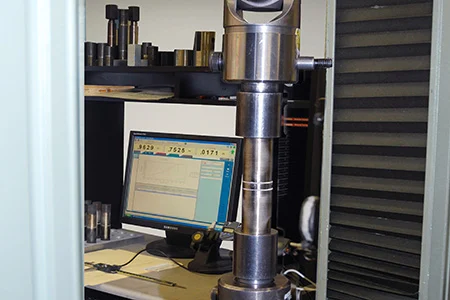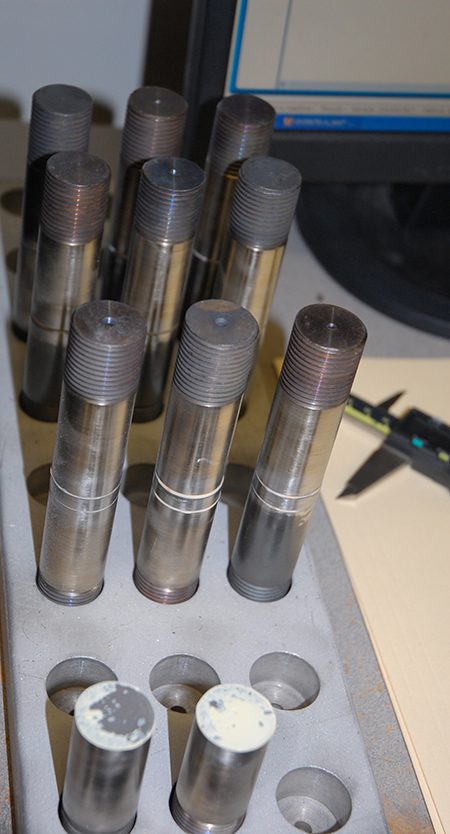Bond Pull Testing
BOND PULL TESTING
In a bond pull test, two materials are bonded together using an adhesive, and then subjected to a pulling force or tensile load in a controlled manner until the bond fails or breaks. The force required to break the bond is measured, and it provides an indication of the strength of the bond. The bond pull test is usually performed using specialized equipment, such as a universal testing machine, which can accurately apply and measure the pulling force.
The bond pull test is used to:
- assess the performance of adhesives
- evaluate the effectiveness of bonding processes
- determine the suitability of adhesive materials for specific applications
- ensure that bonded materials meet required quality standards
It is an important test in the field of adhesives and bonding technology, as it helps ensure the integrity and durability of bonded materials in various applications.
To explore IMR's capabilities for adhesion testing services, request a quote, or click below to contact our experts to discuss a testing plan to meet your needs.


BOND PULL TESTING ANALYSIS
Adhesion Selection
Comparative testing determines the performance of different adhesives, bond strength, the most suitable adhesive for a specific application or intended use case. Process validation.
Failure Analysis
Investigative assessment of when a bonded assembly fails and to determine the mode of failure: adhesive failure, cohesive failure, or substrate failure.
Quality Control
Bond pull testing can be used for quality control by ensuring adhesive performance, detecting bond defects or inconsistencies (poor bonding, incomplete curing, inadequate surface preparation), monitoring process variability (curing time, temperature, and pressure), assessing adhesive batch variability, and statistical process control (SPC) to monitor the performance of adhesive bond over time.
Material Evaluation
Comparing different materials, evaluating material surfacing treatments (cleaning, priming, or roughening), assessing material compatibility, evaluating material aging or degradation, determining bond strength of new materials, and conducting failure analysis are all ways bond pull testing evaluates materials for use in various industries.
Compliance Standards
Bond pull testing may be required to comply with industry standards ore regulations that specify the minimum adhesion strength or performance requirements for bonded assemblies. Adhesives that meet or exceed the requirements my be selected as the appropriate adhesive for the application.

BOND PULL TESTING ASTM C633
ASTM C633 Standard Test Method for Adhesion or Cohesion Strength of Thermal Spray Coatings” determines the adhesion or bond strength of thermal spray coatings. The test method described in ASTM C633 is used to evaluate the adhesion or cohesion strength of the coating to the substrate or between coating layers.
The ASTM C633 standard specifies the equipment, sample preparation, testing procedures, and calculation methods for determining the bond strength of thermal spray coatings. The test involves applying a controlled tensile or shearing force to the coating, perpendicular or parallel to the surface until the coating fails or debonds from the substrate. The maximum force or stress at which the coating fails or debonds is recorded as the bond strength of the coating.
ASTM C633 provides a standardized and widely accepted method for evaluating the bond strength of thermal spray coatings, allowing for consistent and comparable results across different laboratories and industries. It is an important tool for quality control, process optimization, and material selection in thermal spray coatings.
THE BOND PULL TESTING PROCESS
Bond pull testing is performed by:
- Bonding coupons between pull fixtures or attaching special studs to the surface to apply tensile force to determine pull-off strength.
- Using standard load frames or specialized apparatus to measure force and record failure strength.
Fixtures are designed to:
- Apply perpendicular force to prevent cleaving effects that could skew results.
- Ensure accurate and repeatable measurements.
Computer-controlled test frames:
- Automate testing using pre-stored programs.
- Provide immediate data output or export results for further analysis.
Post-Test Analysis:
- Visual examinations assess failure modes - cohesive, adhesive, or mixed - providing insights into bond integrity and material performance.
RELEVANT ACCREDITATIONS
Click here for a complete list of accreditations and certifications for all IMR Test Labs locations.
MECHANICAL TESTING METHODS
Abrasion (Taber)
Adhesion (Peel) Testing
Bend Testing
Bond Strength Testing
Charpy Impact Testing (-320°F to 450°F)
Climbing Drum Adhesion of Sandwich Composites
Coating Adhesion
Coating Shear Fatigue
Coefficient of Thermal Expansion by TMA
Composite Testing (Fiber Reinforced)
Compression Set
Compressive Properties
Core Shear Properties of Sandwich Construction by Beam Flexure
Creep and Stress Rupture Testing
DMA (Dynamic Mechanical Analyzer)
Ductility
Elastic Modulus
Fatigue Testing
Filled Hole Tension & Compression
Flattening
Flat-wise Tensile Testing
Flexural Properties
Floating Roller Peel Strength
Fracture Mechanics
Gel Time
Hardness (Rockwell, Brinell, Durometer, Shore, Barcol, Knoop, Vickers, Macro Vickers)
Heat Aging
Heat Deflection by TMA
Heat Treatment (furnace to 2100°F)
Hydrogen Embrittlement
Hydrostatic Pressure
Indentation Toughness
Interlaminar Shear
Jominy Hardenability
Lap Shear Testing
Machining & Specimen Preparation
Materialography
Modulus of Rupture (MOR)
n-Value (Strain Hardening Exponent)
Open Hole Tension and Compression
Pipeline Integrity Testing
r-Value (Plastic Strain Ratio)
Residual Strength of Composites After Impact
Rotating Beam Fatigue
Shear Testing of Rivets to ASTM B565, Single/Double
Short Beam Strength
Shot Peen Qualification
Single-Edged Notched beams (SENB)
Slow Strain Rate (G129)
Specimen Conditioning
Strain Gaging
Surface Roughness (ANSI/ASME B46.1)
T Peel Strength
Tear Resistance of Films & Sheeting
Tear - Rubbers & Elastomers
Tensile Testing
Torsional and Axial Fatigue (200 lb)
Tube Testing (Tensile, Flare, Hydrostatic)
Welder & Procedure Qualification
Wire/Spring Testing (Wrap, Coil, Bend)
Young's, Tangent and Chord Modulus (Room Temperature)
INDUSTRIES THAT UTILIZE BOND PULL TESTING
Manufacturing
Widely used in manufacturing as quality control and quality assurance, bond pull testing is used in adhesive selection, process validation, and material development.
Construction
Bond pull testing is used in the construction industry to assess the integrity and performance of bonded materials, particularly in applications where adhesives are used for bonding different construction materials. Bond pull testing is commonly used to test concrete bonding, flooring installation, façade and cladding systems, insulation and waterproofing systems, structural bonding, and repair and retrofitting.
Automotive
Bond pull testing is used in the automotive industry for adhesive selection, manufacturing process validation, quality control, failure analysis, material development, and compliance with standards such as ISO/TS 16949:2016 or OEM specifications.
Aerospace
The aerospace industry has stringent requirements for safety, reliability, and durability and bond pull testing plays a crucial role in ensuring that bonded materials and components meet these high standards. It is used for adhesive selection, manufacturing process validation, quality control, failure analysis, material development, and compliance with standards such as AS9100 or specific requirements from regulatory agencies.
Electronics
In the electronics industry bond pull testing is used to evaluate the reliability of bonded components and assemblies such as wire bonds, die bonds, flip chip bonds, solder joints, and other bonds in electrical devices.
BOND PULL TESTING FAQ'S
Bond pull testing is a method used to measure the adhesion or bond strength of adhesive bonds, coatings, or other bonded assemblies. It involves applying a controlled force to a bonded sample until the bond fails or debonds and measuring the maximum force or stress at which this occurs.
Bond pull testing is important because it provides quantitative data on the strength and integrity of bonded assemblies. It is used for quality control, process optimization, material selection, and failure analysis in various industries, such as automotive, aerospace, electronics, construction, and manufacturing. Bond pull testing helps ensure that bonded assemblies meet desired performance requirements and aids in identifying and addressing potential issues related to bonding processes, materials, or designs.
Bond pull testing is commonly used in industries where adhesives, coatings, or bonded assemblies are used, such as automotive, aerospace, electronics, construction, and manufacturing. Some common applications of bond pull testing include evaluating adhesive materials, assessing surface treatments, determining material compatibility, evaluating material aging or degradation, determining bond strength of new materials, and conducting failure analysis.
Several factors can affect bond pull test results, including the type and formulation of the adhesive or coating, the surface preparation of the substrates, the testing conditions (e.g., temperature, humidity), the rate of loading or displacement during the test, and the geometry of the bonded samples. It is important to carefully control these factors during bond pull testing to obtain accurate and reliable results.
Several standards are published by organizations such as ASTM International, ISO (International Organization for Standardization), and others that provide guidelines for bond pull testing in specific industries or applications. Examples of such standards include ASTM D4541 for bond strength of coatings, ASTM C633 for bond strength of thermal spray coatings, ISO 4624 for bond strength of paint coatings, and ASTM D1002 for bond strength of plastics, among others.


